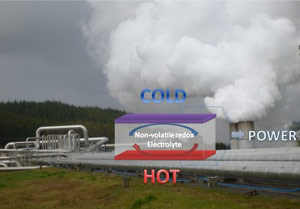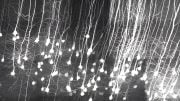
A new, carbon-netural thermocell could harvest waste heat from power stations and convert it into electricity. Credit: Doug MacFarlane and Theodore Abraham
Researchers from Monash University have developed a liquid-based thermocell that could harvest waste heat and convert it into electricity with no carbon emissions.
Harvesting waste heat from power stations and even vehicle exhaust pipes could soon provide a valuable supply of electricity.
A small team of Monash University researchers working under the Australian Research Council (ARC) Center of Excellence for Electromaterials Science (ACES) has developed an ionic liquid-based thermocell. Thermocell technology is based on harnessing the thermal energy from the difference in temperature between two surfaces and converting that energy into electricity. The research is published in the journal Energy and Environmental Science.
Led by Monash University researcher and Australian Laureate Fellow Professor Doug MacFarlane and Monash University PhD student Theodore Abraham, the collaborative project developed the thermocell device with the highest power outputs yet reported and no carbon emissions.
The new thermocell could be used to generate electricity from low grade steam in coal fired power stations at temperatures around 130°C. This would be implemented by having the steam pass over the outer surface of the hot electrode to keep it hot while the other electrode is air or water cooled.
PhD student Theodore Abraham explains how the thermocell works.
Professor MacFarlane said the breakthrough included the development of a novel ionic liquid-based redox electrolyte.
“We have found that it can work at elevated temperatures typical of important heat sources, as opposed to water-based systems, which cannot operate at temperatures above 100 degrees Celsius (212 degrees Fahrenheit),” Professor MacFarlane said.
“The device offers the possibility of a cheap and flexible design suitable for harvesting waste heat in the 100- to 200-degree Celsius (212- to 392-degree Fahrenheit) range.”
PhD student Theodore Abraham said that by using heat already produced in industrial processes that would otherwise be untapped, the thermocell is an attractive method of relieving some of the present reliance on fossil fuels.
“The major benefit of a thermocell is that it harnesses energy that is already readily out there; you’re just harnessing energy that is otherwise lost to surroundings,” Mr Abraham said.
Mr Abraham was supervised by Dr Jenny Pringle of Deakin University who said the development was a significant achievement for a PhD student.
“The advance we made with this system was that we are generating more electrical energy than any previous power cell in this temperature range,” Dr Pringle said.
ACES Director Professor Gordon Wallace said that it took a multitude of skills to tackle complex issues as encountered here.
“Our unique research environment within ACES provides an opportunity to acquire these skills in a cutting-edge research environment,” Dr Wallace said.
Reference: “High Seebeck coefficient redox ionic liquid electrolytes for thermal energy harvesting” by Theodore J. Abraham, Douglas R. MacFarlanea and Jennifer M. Pringle, 17 June 2013, Energy & Environment Science.
DOI: 10.1039/C3EE41608A
Image: Doug MacFarlane and Theodore Abraham









Be the first to comment on "Carbon-Netural Thermocell Could Harvest ‘Waste Heat’"